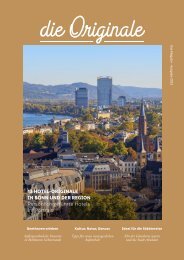LUXAIR_LUXiClub_So12 ls
p o
p
o
Create successful ePaper yourself
Turn your PDF publications into a flip-book with our unique Google optimized e-Paper software.
Number 43, Fall 2002
cartographic perspectives 11
Lanka), the large triangular island in the mouth of the rubricated Red
Sea and Persian Gulf on the map’s southeast edge (top right). Of the
wind gods depicted, eight are dragon-heads spewing fire across the
ocean. Just below Jerusalem, at the center of the map, an enchanting
mermaid admires herself as she rests on the oversized label Mare Mediteranea
[sic]. Her position on the map, coupled with her lack of attire, suggest
the temptations that beguile unwary pilgrims (Letts 1955, in Moir
1970, 36). In the frame at the top, Christ orders sinners after the Last
Judgment into the gaping maw of a dragon-like monster (top right). An
angel announces their fate on a scroll issuing from his trumpet: Leuez—si
alez au fu de enfer estable (“Rise—you are going to the fire prepared in
hell”). While most of the inscriptions on the map are in Latin, the angel’s
words are in Anglo-French, the language spoken by the English court
when the Hereford map was made (Harvey 1997, 54; Westrem 2001, 4).
And gold letters spelling M-O-R-S (“Death”) appear on posts that extend
from the ocean into the map’s frame.
“Most medieval maps, however,
privilege land over water—to
such an extent that the ocean
appears as a narrow ribbon
encircling the continents.”
The Limitations of Mappaemundi for Understanding Birney’s Poem
In many ways, of course, the mappaemundi I have described differ markedly
from the poem they helped inspire. Though “Mappemounde” begins
optimistically with one sea tamed and the other merely “squar[ing]
our map,” this second sea quickly becomes the center of the map, the
poem, and life itself. Most medieval maps, however, privilege land
over water—to such an extent that the ocean appears as a narrow ribbon
encircling the continents. Yet, despite its appearance on maps, the
earth was believed to be spherical by most medieval scholars, including
Honorius. 11 Consider the ball Christ holds in his left hand on the Psalter
map (Figure 1, page 65). It has the “T-O” pattern still recognizable on the
Psalter map itself.
Mappaemundi raise the question: what did the other side of the earth
look like? Though celestial globes were used for educational purposes in
the fourteenth century and earlier, no evidence remains of any terrestrial
globe: for all we know, Martin Behaim’s Erdapfel (“Earth-Apple”) of 1492
is not only the oldest extant globe depicting the earth but perhaps one of
the first made in Europe since classical antiquity (Stevenson [1921] 1974,
1:43-47; Dekker and van der Krogt 1993, 17-18). 12 Medieval scholars are
often vague or conflicting on the subject. The great thirteenth-century
scientist Roger Bacon, for instance, posited that land filled six-sevenths
of the globe (Wright [1925] 1965, 187-188; Bacon [1267-68] 1962, 1:311).
Most others believed that the known world took up only a quarter of
the surface; the possibility of other landmasses existing in the temperate
zones opposite or south of the known world did not necessarily
prevent the ocean from covering half the globe or more (Kimble [1938]
1968, 147, 162-63; Taylor 1966, 53; Westrem 2001, xxxviii). This “oceanic”
theory simply can’t be conveyed on most mappaemundi (Haft 1995, 26-29;
Edson 1997, 110). Nor did the portolan charts fill the void. Until the Age
of Discovery, they typically depicted coastal sections of the Atlantic and
relatively contained bodies of water like the Mediterranean or the Black
Sea. Destinations of merchants and sailors, such waters are pictured as
embraced by shorelines and filled with comforting names of harbors.
Birney, by contrast, focuses on what mappaemundi and portolan charts
omit altogether: the other half of the globe, with its vast ocean stretching
ominously beyond sight of land.
“Mappemounde” proves far less optimistic than its mapped counterparts.
Many mappaemundi illustrate life’s dangers so that the faithful may
“Birney focuses on what
mappaemundi and portolan
charts omit altogether: the other
half of the globe, with its vast
ocean stretching ominously
beyond sight of land.”
“’Mappemounde’ proves far
less optimistic than its mapped
counterparts.”















